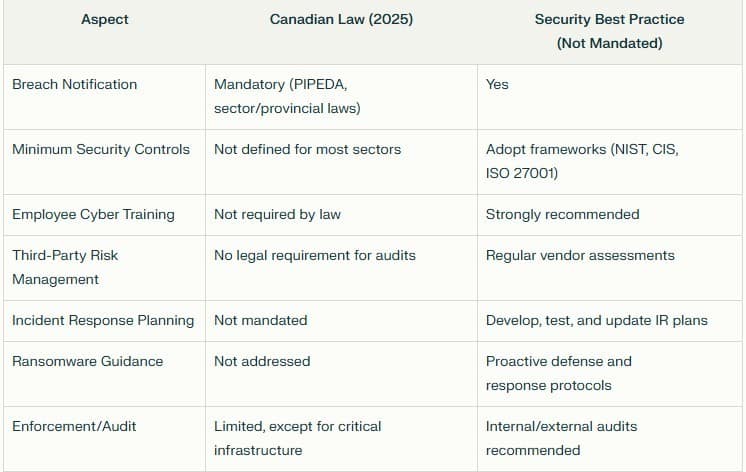If you’re running a business in Canada and you think complying with privacy laws means you’re protected from cyber threats, think again. The truth is, following Canadian cyber legislation might keep you legally compliant, but it won’t necessarily keep you secure. And in today’s threat landscape, that difference matters. A lot.
Let’s be clear: this isn’t about fear-mongering. It’s about reality. And the reality is that cyber threats are evolving faster than the laws designed to protect us. That gap between what’s legal and what’s actually secure? It’s where a lot of Canadian businesses get hurt.
The Rules That Exist—And Why They’re Not Enough
The Personal Information Protection and Electronic Documents Act (PIPEDA) has been the backbone of our federal privacy framework for years. The Digital Privacy Act amended it in 2015 to include mandatory breach notifications. There are also provincial laws like Quebec’s Bill 64, which is rolling out enhanced privacy requirements.
So yes, on paper, there are rules. But those rules are largely reactive. They tell businesses what to do after a breach happens—notify affected individuals, report to the Privacy Commissioner, maybe pay a fine. They don’t offer much when it comes to prevention. There are no mandatory minimums for cybersecurity hygiene. No required frameworks to follow. And outside of regulated sectors like healthcare or finance, there’s very little in terms of oversight or enforcement.
In essence, Canadian law gives you the basic outline of what to do if things go wrong. But it won’t stop them from going wrong in the first place.
Legal Gaps That Leave Businesses Exposed
One of the biggest problems with Canada’s current legislation is that it assumes good intentions and sound practices, but doesn’t demand them. For example, PIPEDA says organizations must have “appropriate safeguards” in place, but it doesn’t define what that means in detail. Is a password-protected spreadsheet enough? A locked filing cabinet? A two-factor-authenticated cloud system? The law doesn’t say.
And when it comes to third-party vendors, the guidance gets even murkier. If your company uses an outside accounting firm or cloud storage service and they get breached, who’s on the hook? You are. But there’s no legal requirement to audit your vendors’ cyber practices—so many businesses don’t. That’s a dangerous blind spot.
Then there’s ransomware. It’s one of the fastest-growing threats facing Canadian organizations today, and yet our legal framework doesn’t provide clear guidance on prevention, response, or even the legality of paying ransoms. That leaves businesses scrambling when they’re at their most vulnerable.
When Following the Rules Isn’t Enough
Let’s talk about some real-world fallout. In recent years, we’ve seen ransomware and data breaches hit Canadian municipalities, hospitals, school boards, and small businesses. In most of these cases, the organizations were compliant with Canadian privacy laws. They had the breach notification protocols in place. They had privacy officers and consent checkboxes.
And yet, they were still attacked.
In fact, many organizations that did everything “by the book” were left offline for days or even weeks, paying out of pocket to recover, rebuild, and restore public trust. Why? Because the law doesn’t demand proactive defense. It doesn’t require ongoing vulnerability assessments, endpoint protection, or employee training. It doesn’t demand that you simulate an attack before you face a real one.
It just asks that you clean up after the fact.
What Proactive Organizations Are Doing Instead
Businesses staying ahead of today’s threats in Canada aren’t doing it because the law tells them to. They’re doing it because the stakes are too high not to.
These are the companies investing in cybersecurity risk assessments—not once, but annually or even quarterly. They’re not waiting for breaches; they’re hunting for weaknesses before the attackers do. They’ve developed their own internal security policies that go beyond what the law requires. They’re training their staff, testing their backups, running tabletop exercises, and building response playbooks.
They’ve adopted cybersecurity frameworks—like the NIST Cybersecurity Framework or the CIS Controls—as guides, even if those aren’t mandated in Canada. They’re using endpoint detection and response tools, monitoring their networks in real time, and partnering with cybersecurity professionals who can evolve alongside the threat landscape.
They’re not just aiming for compliance. They’re aiming for resilience.
If You Wait for Laws to Catch Up, You’ll Be Waiting Too Long
Cyber criminals don’t care about compliance. They care about opportunity. And every time we wait for legislation to catch up, we give them more of it.
The truth is, Canadian laws are always going to lag behind technology. That’s not a flaw of government—it’s just the nature of lawmaking. It takes time to study, draft, consult, debate, and implement legislation. But cyber threats evolve in days, not decades.
The organizations that understand this are the ones thriving. They know that being “within the law” doesn’t mean being safe. They know that public trust is harder to win back than any fine is to pay. And they know that reputation, downtime, and data loss cost more than most insurance policies cover.
The Culture Shift Canadian Businesses Need
One of the biggest changes happening in cybersecurity isn’t technical—it’s cultural. Forward-thinking organizations in Canada are shifting their mindset. They’re no longer asking, “What’s the minimum we need to do to be compliant?” They’re asking, “What’s the smartest way to protect our business and our people?”
That means cybersecurity is no longer something handed off to the IT department. It’s a boardroom topic. It’s something that gets budgeted for, reviewed regularly, and reported on at the highest level. It’s embedded into operations, HR, procurement, and customer service—not just a dusty policy in a binder.
And it’s not just about ticking boxes. It’s about building awareness and accountability from the inside out.
So What Should Canadian Businesses Do Anyway?
If the law is the floor, then businesses need to build their own ceiling. That starts with a risk assessment. Not a generic one—a proper review of where your data lives, who accesses it, how it’s protected, and what happens if it’s lost.
From there, businesses should implement layered security. Firewalls and antivirus aren’t enough. You need endpoint protection, user access controls, encryption, and automated patching. You need a real incident response plan—tested and updated. And most importantly, you need a cyber-aware team.
Training employees to recognize phishing attempts, use strong passwords, and report suspicious activity can stop attacks before they even begin. You don’t need a massive budget to start, but you do need a commitment to act.
Even simple steps like enabling multi-factor authentication, setting up off-site backups, and limiting admin privileges can make a massive difference. And if you don’t have internal expertise, there are cybersecurity experts—like Adaptive Office Solutions—who live and breathe this work. Partnering with one could be the smartest business decision you make this year.
Final Thought: Don’t Wait for Permission to Protect Yourself
If you’re waiting for Canada’s cybersecurity laws to be rewritten, strengthened, or better enforced, don’t hold your breath. The legal system will always move more slowly than cybercrime. That’s not an excuse to stand still. It’s a reason to move forward.
Canadian businesses have the power—and the responsibility—to protect themselves, their clients, and their futures. Compliance might satisfy the letter of the law, but proactive cybersecurity is what will protect you when the law comes up short.
So don’t just do what you’re told. Do what’s smart.
At Adaptive Office Solutions, cybersecurity is our specialty. We prevent cybercrimes by using analysis, forensics, and reverse engineering to detect malware attempts and patch vulnerability issues. By investing in multilayered cybersecurity, you can leverage our expertise to boost your defenses, mitigate risks, and protect your data with next-generation IT security solutions.
Every device connecting to the internet poses a cybersecurity threat, including that innocent-looking smartwatch you’re wearing. Adaptive’s wide range of experience and tools fills the gaps in your business’s IT infrastructure and dramatically increases the effectiveness of your cybersecurity posture.
To schedule a Cyber Security Risk Review, call the Adaptive Office Solutions’ hotline at 506-624-9480 or email us at helpdesk@adaptiveoffice.ca




